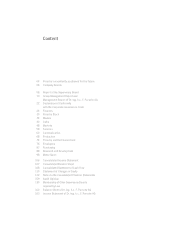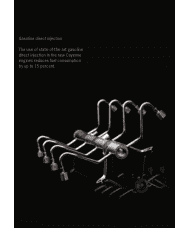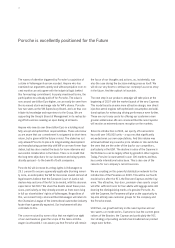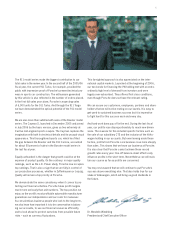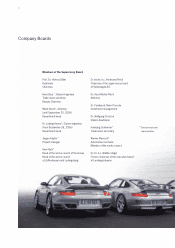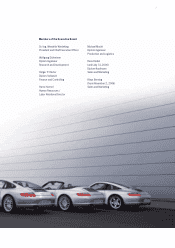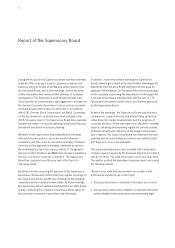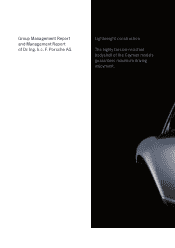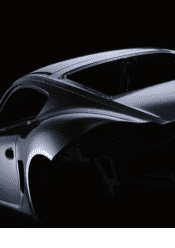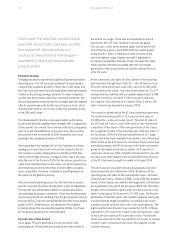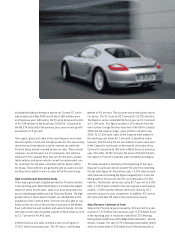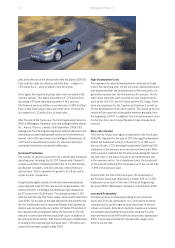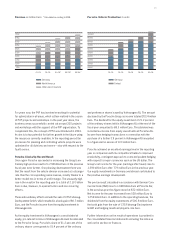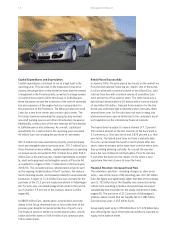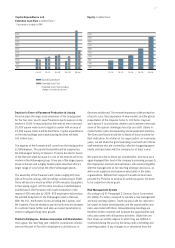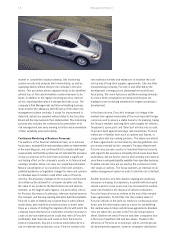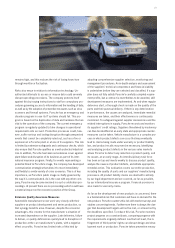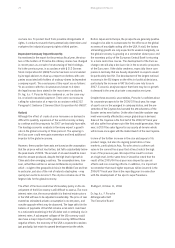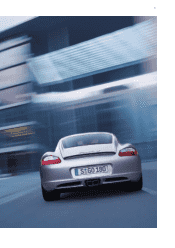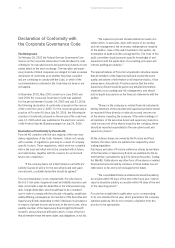Porsche 2005 Annual Report Download - page 14
Download and view the complete annual report
Please find page 14 of the 2005 Porsche annual report below. You can navigate through the pages in the report by either clicking on the pages listed below, or by using the keyword search tool below to find specific information within the annual report.12
Once more, Porsche has closed a fiscal
year with record sales, turnover, produc-
tion and profit. Special influences –
such as its investment in Volkswagen –
prompted a clearly disproportionate
jump in profits.
Economy Soaring
The global economy experienced significant growth during the
reporting year. The US economy provided the main impetus,
coupled with unabated growth in China. Also, both Japan and
the Euro zone recovered from the weak phase they had endured.
Thanks to the strong earnings situation of many companies
and the fact that interest rates have remained moderate, the
factors buoying the economy were far stronger than any negative
effects caused especially by the rise in the price of oil, which
at times was extreme, and a more restrictive monetary policy
in the USA and Europe.
The development in the Euro zone was positive on the whole,
as Germany and Italy regained their strength after a long period
of zero growth. As a result, the economy in the Euro zone gained
pace at a rate unparalleled for many years now. The recovery
that started in the second half of 2005 developed into a real
upswing in the spring and summer of 2006.
Germany played the leading role for the European economy,
making up around 28 percent of economic output in the EU.
The German economy displayed more growth in 2006 than
experts had initially forecast. In August 2006, just a few days
after the end of the Porsche 2005/06 fiscal year, growth fore-
casts were adjusted and in some cases corrected upwards by
more than two percent for the whole of 2006. With companies
more competitive, Germany continued to benefit greatly from
the upturn in the global economy.
One particularly pleasing aspect for the German economy
was the revival of domestic demand after years of stagnation.
This growth was attributable equally to capital expenditure
and spending by private consumers. These two developments
may be special effects resulting from the government’s plan to
increase VAT by 3 percent and abolish the first-time home-buyers
grant in 2007. Nevertheless, the dynamism of the global
economy shows that any possible negative effects from these
tax measures should not be overestimated.
Porsche Sets a New Record
Once again, Porsche generated record unit sales in the
reporting year. This growth was driven by the new models in
our sports car range. There was an extraordinary level of
demand for the 911 from customers all over the globe.
The success of this series peaked again shortly before the
end of the fiscal year in June 2006 with the market launch
of the new 911 Turbo. Furthermore, both versions of the
new mid-engined coupe Cayman met with a high level of
acceptance during their first year of sale. As expected, sales
of the Cayenne declined somewhat after the first model
generation of the sporty all-terrain vehicle reached the end
of its life cycle.
At the same time, unit sales for the Cayenne in the reporting
year matched the high level of the 911. 34,134 vehicles from
Porsche’s third series were sold, after sales of 41,884 units
in the previous fiscal year. Unit sales break down into 13,077
standard-version vehicles with six-cylinder engines and 15,088
Cayenne S vehicles. A total of 5,969 units were sold from
the Cayenne Turbo and the new Cayenne Turbo S series, the
latter of which was launched in January 2006.
The course for growth set by the 911 was extremely impressive.
The model achieved growth of 23.6 percent with sales of
34,386 units – a new unit sales record. The start of sales of
the GT3 and the Turbo in June 2006 more or less marked the
completion of the launch of the new generation of the classic
911 on global markets in the reporting year. After the close of
the fiscal year 2005/06 this was followed by the 911 Targa
model, which has been available from dealers since November
2006. As far as the 911 Carrera is concerned, the S version was
particularly popular, with 66.6 percent of all Carrera customers
going for the higher-performance model. 43.4 percent of
customers chose one of the Cabriolet versions and 41.1 percent
of Carrera unit sales related to the new all-wheel drive versions
of the 911 that were brought to market in October 2005.
The new Cayman S has been introduced gradually onto inter-
national markets since November 2005. By the end of the
reporting year, unit sales for the mid-engined coupe – allocated
to the Boxster series – totaled 12,868. In July 2006 the standard
version of the Cayman was added to the range and 1,134 vehicles
were sold before the end of the fiscal year 2005/06. The entire
Boxster series benefited significantly from the success in unit
sales, increasing by 55.0 percent to 27,906 units. The Boxster
and Boxster S held their own in the roadster segment, which was
characterized by tough competition at a global level. 8,430
standard-version vehicles were sold in the reporting year. The
higher-performance Boxster S accounted for 5,474 of these,
equivalent to 39.4 percent of sales. In the previous year, sales
of the S version made up 45.9 percent in total. The Boxster
series was enhanced in the new 2006/07 fiscal year to include
modern, lower-consumption VarioCam Plus engines in both
roadster versions.
Management Report


